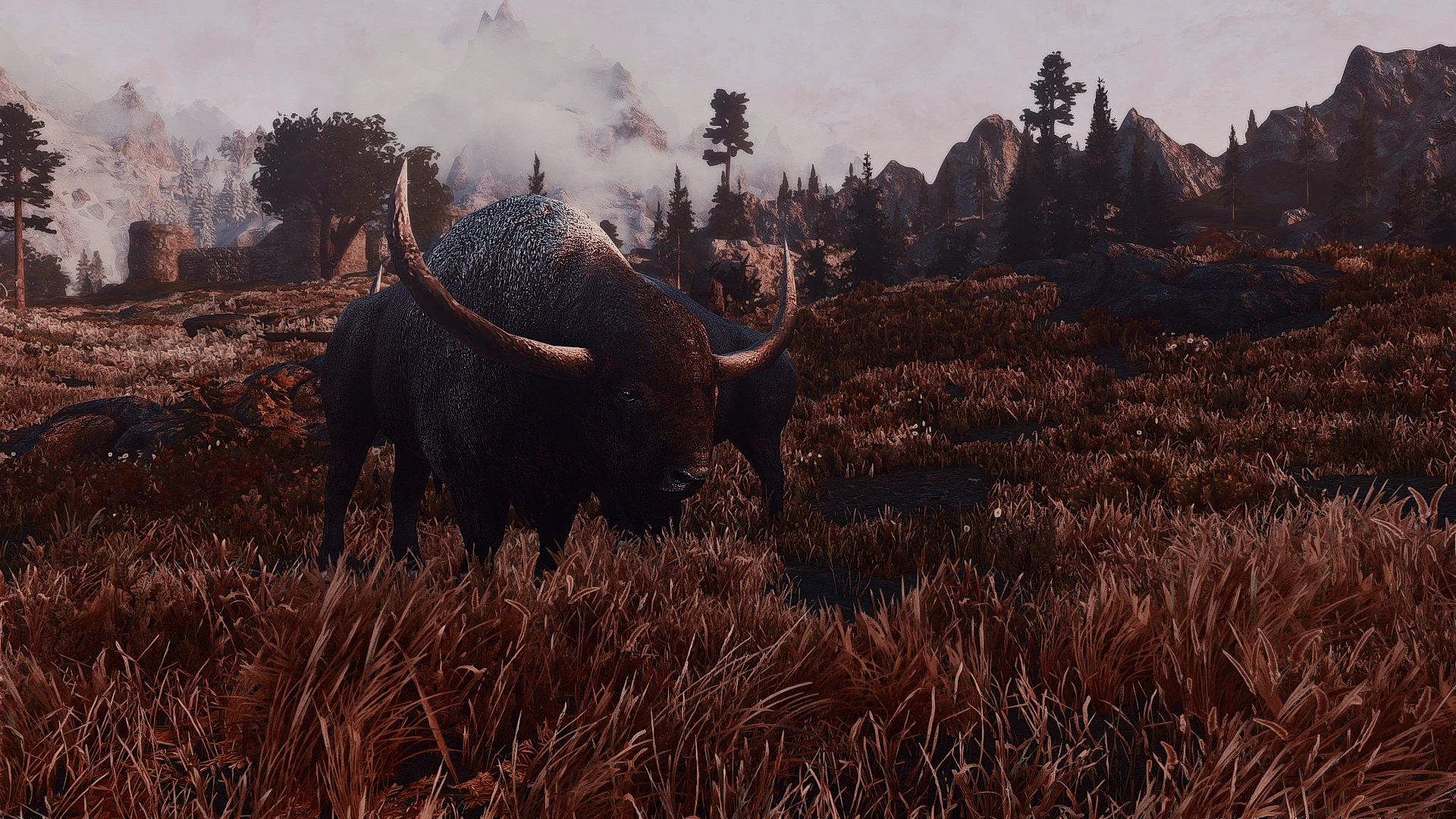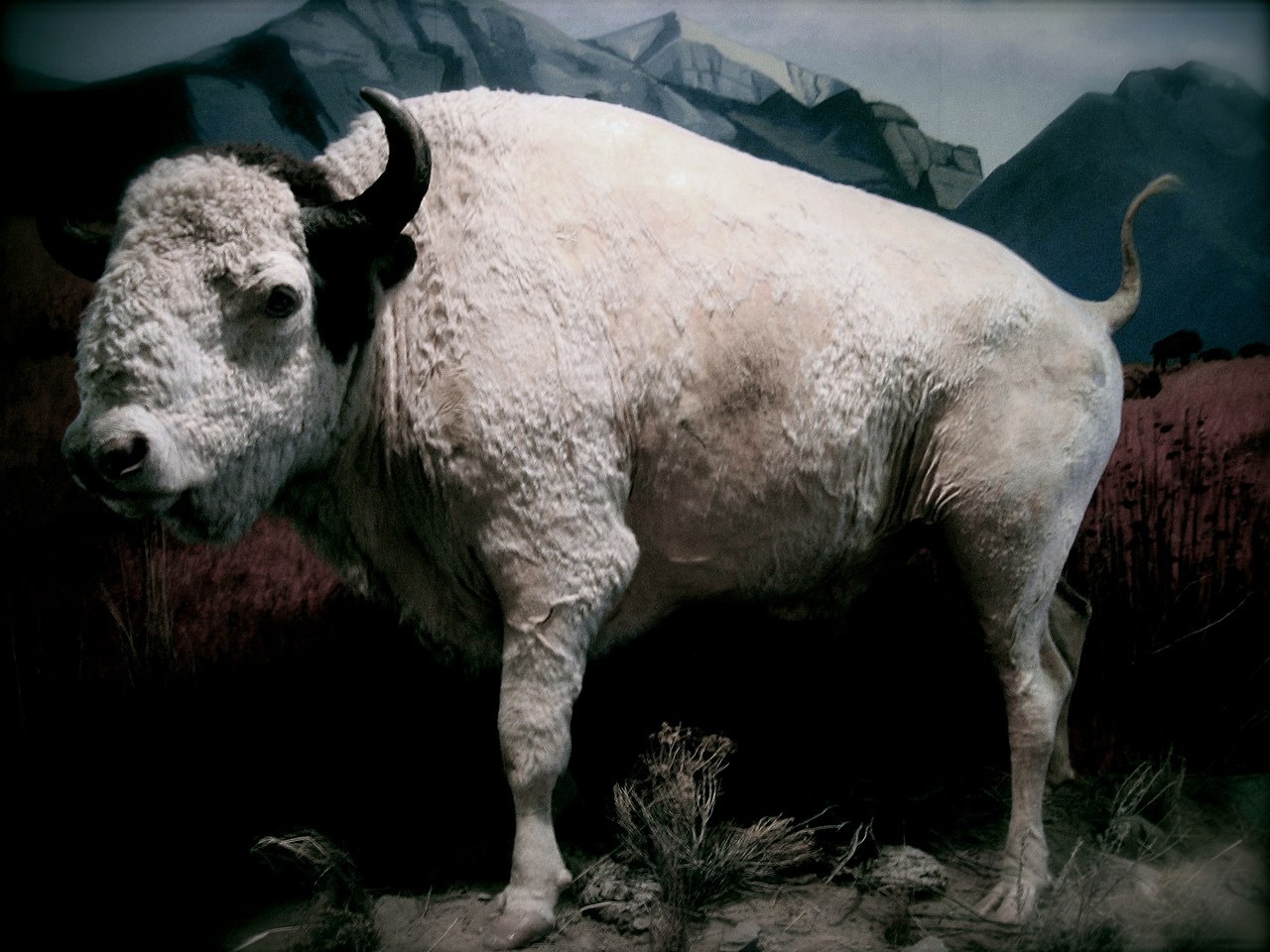Arkael Winset
One of the largest Bovine to ever inhabit the planet, Bison latifrons Arkaelie or the Arkael Winset is one of the largest bovidae that has inhabited the planet, even dwarfing Bovine such as the Auroch.
An absolute icon of prehistory come to life within a strange new world, this gigantic species of Bison takes on the role of its namesake as one of the most impressive and largest species of Buffalo known to man, even dwarfing the Extinct Bison latifrons of Earth in both size and weight. Despite this drastic change in size however, not much separates this gigantic bovine from other members of its kind.
Appearance
The Arkael Winset, are some of the largest surviving terrestrial animals native to the wilds of Arkael. They are typical artiodactyl (cloven hooved) ungulates, and are similar in appearance to other bovines. They are broad and muscular oftentimes with shaggy coats of long hair. Compared to the largest bison on earth the European Bison and its extinct relative Bison Latifrons, The Arkael Winset is considerably much larger than the two, though not by much in terms of general description. Because only skulls and horns of Earth Latifrons have ever been found well preserved, the size of B. latifrons is currently not clearly known. However the size of Arkael Winset is thought to be double that size with large males being considerably larger than females. Overall, compared to Earth Latifrons, which probably was around 4.75 m (15.6 ft) in length and stood about 2.3 m (7.5 ft) or up to 2.5 m (8.2 ft) tall at the withers, the Arkael Winset is almost 20ft at full length and stands nearly 10 (in females) and 15 (in males) at the withers. With an estimated weight of 3,760 lb to 5,400 lb, they are also drastically much heavier than their earth counterparts. The horns of earth B. latifrons measured as great as 213 centimeters (84 in) from tip to tip. The horns of Arkael Winset are nearly double that as well, with massive older males often pushing horn sizes at around 8-10 feet in length at a time. Females tend to be half that or smaller, but can reach remarkable sizes too similar in shape to that in other extinct Earth Bison like the Steppe Bison, Bison Priscus.Distribution and Habitats
Unlike the Bison of Earth whose range is now often cultivated by where conservationists place them, the Arkael Winset has a much wider and more prolific range. While females and young due to their smaller size tend to live in forested areas with low brush, males are known to live in river valleys, and on prairies and plains. Typical habitat for both sexes regardless of age is often open or semi open grasslands, as well as sagebrush, semi arid lands, and scrublands. They will also graze in hilly or mountainous areas where the slopes are not steep. Though not particularly known as high-altitude animals, most herds are known to be frequently found at elevations above 2,400 m (8,000 ft). Other herds have been observed to roam mountainous areas including high ridges and steep drainages, and archaeological finds indicate some past Winset's historically may have spent their lives within mountains while others may have migrated in and out of mountains. In addition, Reproduction is limited by the amount of habitat available. Winset tends to disperse when there is not enough food to sustain a population within the current range, which causes a decrease in population density, indirectly lowering the rate at which mating occurs, thus keeping the animals from becoming too overpopulated. Older bulls will typically have smaller ranges than female herds, because they live either solitarily or in smaller herds and therefore exert less pressure on the local forage. However in many places, this often leads to the unexpected situation of die-out, as loss of functional habitat due to human/mer excursion is a major ecological concern for this species due to the density-dependent nature of reproduction.Diet
Winset are herbivorous grazers that feed primarily on grasses, sedges, and forbs. Due to frequent and heavy snowfall in their native habitat, food availability fluctuates throughout the year, leading to a diverse and varied diet. Deep snow often creates a barrier between the Winset and their food source, so they must use their large heads and neck muscles to dig for edible morsels. In the more wooded areas of their ranges, they feed predominantly on grasses, although they also browse on shoots and leaves; in summer, an adult male can consume 42 kg of food in a day, thought they may also lessen their diet during the winter months due to fat stored within their hump providing them with energy and nutrition.Breeding
Breeding between Arkael Winset is no different than what occurs in Earth Bison. Like most other cattle, Arkael Winset are herd-living animals with a distinct social hierarchy. Males are the larger gender and battle ferociously in the spring to determine mating rights, spending the rest of the year in ornery bachelor herds; the females and their calves congregate into much larger herds, which are usually led by an old matriarch. The rutting season occurs from August through to October, though many bulls may attempt earlier to gather up as many females as they can, during which Bulls aged 4–6 years, though sexually mature, are prevented from mating by older bulls. Body size in males increases proportionately to the age of 6 years. While females have a higher increase in body mass in their first year, their growth rate is comparatively slower than that of males by the age of 3–5. Bulls reach sexual maturity at the age of two, while cows do so in their third year. The gestation of an Arkael Winset is remarkably long, with the time period ranging nearly two years, and young remain with their mother for their first two years. Winset have lived as long as 30 years in captivity, but in the wild their lifespans are shorter. The lifespan of an individual in the wild is usually between 18 and 24 years, though females live longer than males. Productive breeding years are between four and 20 years of age in females, and only between six and 12 years of age in males, though this range is slightly different in certain malesPredation
Winset, despite their normally calm demeanor can be extremely dangerous if provoked. But they are not entirely invulnerable. Large predators, such as Warg, Dragons, Sabre's, large species of Wolves and various Neodino species will all try their shot at taking down injured, old, or young winset with varying degree's of success. In additon Humans Mer and Beastman will also hunt them as well. However, hunting Winset for subsistence and/or trophies is extremely dangerous and not recommended for the faint of heart – even experienced buffalo hunters will cower in fear at the charge of an enraged bull.Coloration
Like Earth Bison, Winset have a shaggy, long, dark-brown winter coat, and a lighter-weight, lighter-brown summer coat. However also like Bison, they can come in a variety of Fur Variants such as Albino Brown Dark Brown Light Brown Grey Light Grey Dark Grey Melanistic Leucistic and Piebald Albino Melanistic and Piebald are the rarest of the coat variations. So much so that out of a total of 750,000 Winset killed, only two were ever albinos. More specifically, the probabilities for any given rare coat tend to go as such: Albinos are 1 in 2000, Melanistic and leucistic animals are 1 in 600, and Piebalds are 1 in 350. However this also depends on range and predation within the range, Piebald Winset are much more common in certain ranges with some studies showing the trait may show up in one in 1,000 animals. Albinism is much rarer and may only be observed in one in 30,000 but some studies also suggest the range can be much higher to almost 80 thousand or more.Religious Significance
Whatever the range in number probablity, White Winset are extremely rare. Because of this the occurrence of a white winset is said to be a sacred sign in several religions across Arkael, where the birth of a white calf is a sign of prosperity and good fortune as they are considered sacred or spiritually significant. Such animals are often visited for prayer and other religious rituals. White buffalo can result from one of several physical conditions:- They may be albinos, in which case they will remain unpigmented throughout their lives, and may also have hearing and vision problems due to genetic issues as Albinism does not usually cause this.
- They may be leucistic, with white fur but blue eyes, instead of the pink seen in albinos.
- They may have a rare genetic condition which causes a Winset to be born white, but to become brown within a year or two as it matures.
Triva
- There are many legends that surround the Winset. In one of the most popular, it is said that the stars disappeared from the sky once:
A bull with horns so large and proud, they scraped the sky, pulling and plucking and taking all the stars in their wake. The Gods, angry with the Winset who seemed proud of its feat to tear the very stars from the heavens, created the largest creature they could come up with in order to cease its activites, since many before it were afraid of its strength. A creature which would be fierce, but loyal and a lover of the night. In the ensuing battle, the stars were shed from its horns and as the creatures attacked the Bull, valiant Ichor spilled from its body and flowed like blood across the sky, creating the rippling Aurora of the North. Now whenever you see few or dont see any stars in the sky, it is the Bull, trying to take back what he believed to be his and the Aurora is there to show the constant struggle to regain the stars back.
- It is thought that the "Creature" the gods created to stop the Star-thief were Wargs. Massive wolf like creatures, they are the only ones noted to be brave enough to face a healthy Winset in battle, where even dinosaurs and smaller dragons know better. The dynamic between them has even been found in old scripture and cave-drawings
- Much like all Bison, Winset temperament is often unpredictable. They usually appear peaceful, unconcerned, even lazy, yet they may attack anything, often without warning or apparent reason
- Similiar to all other animals, Winset have been observed to display homosexual behaviors, males much more so than females. In the case of males, it is unlikely to be related to dominance, but rather to social bonding or gaining sexual experience.
- Winsets make a variety of vocalisations depending on its mood and behaviour, but when anxious, it emits a growl-like sound. Their bellowing is said to be much louder then normal Bison and travels farther in plains ranges
Domain: Eukaryota
Kingdom: Animalia
Phylum: Chordata
Class: Mammalia
Order: Artiodactyla
Family: Bovidae
Subfamily: Bovinae
Genus: Bison
Species: B. latifrons Arkaeliae
Ranking: Megafauna (beast type)
Behavior Normally calm, but highly agressive at close range
Habitat: Prefer to live in forests with a lot of undergrowth at a young age. Females will stay in the forests while males will move out to the plains once their horns become to large to maintain safely amongst the tree's.
Senses: Very good sense of smell, extremly poor eyesight
Social: Males are typically solitary. Females live in medium-sized groups.
Active: During Dusk and Night






Comments